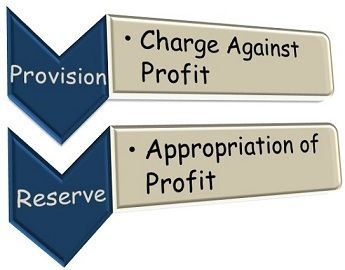Meaning of Provisions
“Any amount written off or retained by the way of providing depreciation or diminution in the value of assets or for providing any known liability of which the amount cannot be determined with substantial accuracy.”
– The Institute of Chartered Accountants of India
“Liabilities which can be measured only by using a substantial degree of estimation.”
– AS-29 issued by Institute of Chartered Accountants of India
AS 29 also defines liabilities as “a present obligation of the enterprises arising from past events, the settlement of which is expected to result in an outflow from the enterprise of resources embodying economic benefits.”
Debiting Profit and Loss account, provisions are created and shown either deducting assets side or on the liabilities side under relevant sub-head of Balance Sheet.
Provision for bad and doubtful debts, Provisions for Repair & Renewals, and Provision for discounts & depreciation are the most common examples.
Meaning of Reserves
“That portion of earnings, receipts or other surplus of an enterprise (whether capital or revenue) appropriated by the management for general or a specific purpose other than a provision for depreciation or diminution in the value of assets or for a known liability.”
-ICAI
Reserve is an appropriation of profits; on the other hand, Provision is a charge against profit. Reserves are not meant to meet out contingencies or liabilities of a business. Reserve increases working capital of a company to strengthen the financial position.
There are two types of reserves −
· Capital Reserve − Capital reserve is not readily available for distribution as the dividends among the shareholders of the company, and it creates only out of capital profit of the company. It is like Premium on issue of shares or debentures and Profit prior to incorporation.
· Revenue Reserve − Revenue reserves are readily available for the distribution of profit as dividend to the shareholders of the company. Some of the examples of this are general reserve, staff welfare fund, dividend equalization reserve, debenture redemption reserve, contingency reserve, and investment fluctuation reserves.
Distinction between Provisions and Reserves
· Reserve can be made only out of profit and provisions are the charge to profit.
· Reserves reduce divisible profits and provisions reduce the profit.
· Reserves, if remain un-utilized for some period can be distributed as dividends, but provisions cannot be transferred to General Reserve for the distribution.
· Purpose of provision is very specific, but reserve is created to meet out any probable future liabilities or losses.
· Creation of provisions is legally necessary, but reserves are created to save a concern from the future losses and liabilities.
Secret Reserves
Banking Company, Insurance Company, and Electricity Companies create secret reserves, where the public confidence is required. In this case, to create secret reserve, assets showed at lower cost or liabilities at higher value. Some of the examples of it are as follows −
- By undervaluing goodwill or stock
- By excessive depreciation
- By creating excessive provisions
- Showing free reserves as creditors
- By charging capital expenditure to profit and loss account
Advantages of Secret Reserves
Some of the important advantages are given below −
· Without disclosing to its shareholders, it increases working capital of a concern, which is a clear indication of the sound financial position.
· With the help of secret reserves, directors can maintain the rate of dividends during the unfavorable time.
· Non-disclosure of a big profit is useful to avoid an un-due competition.
Limitations of Secret Reserves
Major limitations or objections of secret reserves are as follows −
· Due to non-disclosure of actual profit, financial statements do not presents true and fair view of the state of affairs.
· There are lots of chances of misuse of reserves by the directors for their personal benefits.
· Due to secret reserves, chances for the concealment of worst position of a company are very high.
· Company will get very lower amount of claim of insurance at the time of loss of stock or other assets, as valuation of the assets are done at very low value to create secret reserve.
General and Specific Reserves
Specific reserves are created and utilized for the purpose only for which they are created, like dividend equalization reserve and debenture redemption reserve.
General reserves are created for any future contingency or to utilize at the time of expansion of a business. Purpose of creation of General reserve is to strengthen the financial position of the company and to increase the working capital.
Sinking Fund
For the purpose to repay of any liabilities or to replace any fixed assets after particular period, sinking funds are created. For this, some amount are charged or appropriated from the profit and loss account every year and invested in any outside securities. Without any extra ordinary burden, replacement of an asset may be done in a systematic manner or pay any known liability on maturity of the sinking fund.
Investment of Reserves
It is a controversial issue, whether a reserve should be invested in outside securities or not. Thus, to decide anything, it is important to study the need and requirement of a firm according to the financial position of a firm. Therefore, investment in outside securities is justified only in a case where company has the extra fund to invest.
Nature of Reserve
In-spite of showing reserves on the liabilities side of a Balance Sheet, reserves are actually not at all any liabilities of a firm. Reserve represents as accumulated profits, which are available to disburse among the shareholders.



Comments are closed